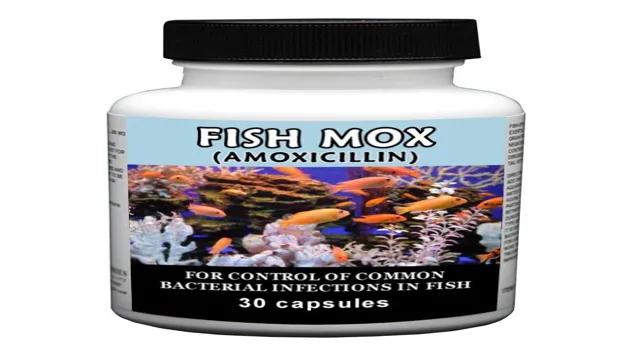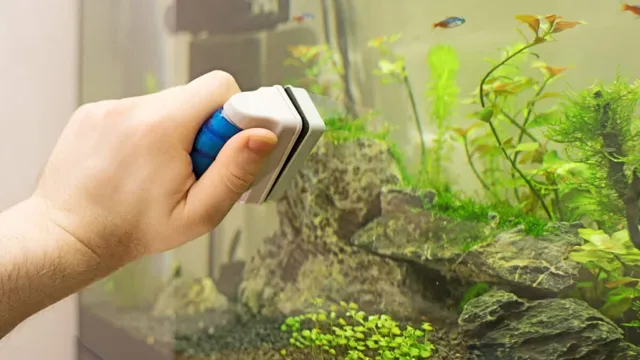If you’re a fish enthusiast, you know that fish mox capsules offer great benefits in keeping your aquatic pets healthy. However, dosing these capsules in your aquarium requires a bit of knowledge and expertise. Whether you’re dealing with a bacterial infection or just want to prevent your fish from getting sick, proper administration of fish mox capsules can make a huge difference.
Dosing fish mox capsules in your aquarium may seem daunting at first, but it’s not as complicated as it may seem. With the right approach, you can safely and effectively treat your fish while avoiding any unwanted complications. In this blog post, we’ll explore everything you need to know about administering fish mox capsules in your aquarium.
From choosing the right dosage to understanding the potential side effects, we’ll cover all the essential information to ensure your fish stay healthy and happy. So, if you’re ready to learn more about dosing fish mox capsules in your aquarium, let’s dive in! Whether you’re a seasoned fish keeper or just starting on this exciting hobby, this article will provide you with the knowledge and confidence you need to properly medicate your aquatic pets.
What is Fish Mox?
If you’re wondering what Fish Mox is, it’s a type of antibiotic that’s primarily used to treat bacterial infections in fish. However, some people use it as a cost-effective way to provide medical treatment for their aquarium fish, especially if they can’t afford to take them to a veterinarian. If you’re thinking of using Fish Mox capsules to treat your fish, it’s essential to understand the dosage and how to administer it correctly.
Generally, the recommended dosage is one 500mg capsule per ten gallons of water, that’s dissolved in water first before being added into the aquarium. However, specific details, such as the severity of the infection, the size of your fish, and other factors, can play a role in determining the right dosage. Therefore, it’s recommended to talk to your aquatic veterinarian or a knowledgeable fish expert to determine the appropriate Fish Mox dosage for your fish.
Heading Three: Definition and Uses
Fish Mox is a type of fish antibiotic that’s becoming increasingly popular in the survivalist and prepper communities. The active ingredient in Fish Mox is amoxicillin, which is the same antibiotic prescribed by doctors for common bacterial infections. While Fish Mox is not intended for human use, many believe it can be used as a substitute for human amoxicillin in a pinch.
However, it’s important to note that Fish Mox is not FDA approved for human consumption and could potentially be harmful or ineffective if used improperly. It’s always best to obtain prescription medications from a licensed healthcare provider. Fish Mox should only be considered for emergency situations where professional medical attention is not immediately available.

Determining the Proper Dosage of Fish Mox
Fish mox capsules can be a useful medication to have on hand for fish owners. However, it’s important to properly dose the medication in order to get the desired results without harm to the fish. The correct dosage will depend on the size and type of fish, as well as the severity of the condition being treated.
As a general rule of thumb, one 250mg capsule of fish mox should be added to every 10 gallons of water in the aquarium. It’s important to note that fish mox should only be used under the guidance of a veterinarian or other knowledgeable professional. Overdosing can be harmful to fish, and using the wrong medication for a specific condition can worsen the problem.
As with any medication, it’s important to carefully read and follow the instructions on the label, and to seek professional advice if needed.
Heading Three: Factors to Consider
Determining the proper dosage of fish mox is a crucial factor to consider when treating fish diseases. This medication is a type of amoxicillin that is commonly used in the aquarium industry. The dosage of fish mox depends on many factors, such as the type of fish, the severity of the disease, and the size of the aquarium.
It is always recommended to consult with a veterinarian before administering any medication to fish. A veterinarian can provide the correct dosage and advice on how to properly administer the medication. Overdosing can lead to adverse side effects and even death, while underdosing may not effectively treat the disease. (See Also: How to Clone Golden Pothos for Aquarium: A Step-by-Step Guide)
It is important to follow the instructions and dosage guidelines provided by the veterinarian or the manufacturer when using fish mox. By properly dosing the medication, we can effectively treat the disease and ensure the health and well-being of our aquatic pets.
Heading Three: Recommended Dosages for Different Fish Species
When it comes to using fish antibiotics, such as Fish Mox, it’s important to determine the proper dosage based on the specific species of fish you have. Different fish require different amounts to effectively treat infections. For example, a small, ornamental fish may only require a fraction of the dosage needed for a larger, commercial fish.
It’s always best to consult a veterinary professional before administering any type of medication to your fish. They can help you determine the correct dosage and ensure that you’re treating the infection properly. It’s also important to note that overdosing your fish can have serious consequences and may even lead to death.
So, be sure to follow the recommended dosage instructions carefully and closely monitor your fish’s behavior and health throughout the treatment process. With the right dosage and proper care, Fish Mox can be a highly effective treatment option for a variety of fish infections.
Administering Fish Mox to Your Aquarium
Administering Fish Mox capsules to your aquarium can be a great way to treat bacterial infections in your fish. But, before administering the medication, it’s important to understand how to dose the capsules properly. To start, identify the specific type of infection your fish has, as different infections require different amounts of medication.
Next, calculate the proper dosage based on the number of gallons of water in your aquarium. Fish Mox capsules typically come in 250mg or 500mg doses, with the recommended amount being 250mg per 10 gallons of water. Crush the capsule and mix it with fish food or water before administering it to your fish.
It’s essential to treat the fish for an extended period of time, usually 5-7 days at least, even if they appear to be recovering. Keep in mind that Fish Mox should only be used to treat bacterial infections and not viruses. Administering Fish Mox capsules in your aquarium can be done safely and effectively with proper dosing and treatment.
Heading Three: Methods of Administration
Administering Fish Mox to Your Aquarium Administering medication to a fish can be a challenging task, but it’s essential for their well-being. Fish Mox is a popular antibiotic that can be used to treat a wide range of bacterial infections in fish. One of the easiest ways to administer Fish Mox is by mixing it with the fish’s food.
Crush the tablet and mix it with food when feeding the fish. This method is effective but can take a while for the medication to take effect. Alternatively, you can dissolve the tablets in water and add it to the aquarium.
The water method has a more immediate effect, but you need to be cautious not to overdose the fish. Overdosing can cause more harm than good. Always use the recommended dosage, and if you’re unsure, consult a veterinarian or an experienced aquarium hobbyist.
Administering Fish Mox to your aquarium can keep your fish healthy, and it’s always better to be safe than sorry.
Heading Three: Precautions to Take When Administering Fish Mox
Administering Fish Mox to your aquarium may seem like a simple solution to treat bacterial infections in your fish. However, before deciding to use this medication, precautionary measures should be taken. First and foremost, it is crucial that you properly identify the type of bacterial infection your fish is suffering from so you can select the appropriate antibiotic. (See Also: How to Clean Algae from Aquarium: The Ultimate Guide to a Crystal Clear Tank)
Secondly, it is essential that the medication is administered in the correct dosage and for the appropriate length of time. Make sure you read the instructions carefully and follow them precisely. Additionally, be sure to monitor your fish closely during treatment to ensure that any adverse reactions are detected early on.
Lastly, always remember to maintain proper water quality and ensure that your fish’s environment is suitable for healing. Administering Fish Mox can be an effective treatment for bacterial infections, but it should always be done with caution and with the guidance of a veterinarian or experienced aquarist.
Monitoring Your Aquarium After Administering Fish Mox
After administering fish mox capsules in your aquarium, it’s important to monitor your fish carefully. First and foremost, ensure that you’ve followed the correct dosage instructions based on the size of your aquarium and the number of fish you have. Overdosing or underdosing can cause serious harm to your fish, including death.
Once you’ve administered the medication, keep a close eye on your fish for any signs of improvement or worsening of their condition. Look out for changes in their behavior, appetite, and appearance. It’s also essential to regularly check the water quality in your aquarium and perform any necessary water changes to ensure a healthy environment for your fish.
Remember that fish mox capsules are an antibiotic, so you don’t want to overuse them, which can lead to antibiotic resistance in your fish. If your fish are still exhibiting symptoms after the prescribed treatment period, consult with a veterinarian who specializes in aquatic medicine.
Heading Three: Signs of Improvement to Look for
If you’ve recently administered Fish Mox to your aquarium, it’s important to monitor the fish for signs of improvement or worsening conditions. One sign of improvement to look for is increased activity and appetite from the fish. If they seem more lively and interested in food, it’s a good indication that the antibiotic treatment is working.
Additionally, if the fish’s physical symptoms, such as redness or swelling, start to decrease or disappear altogether, it’s a positive sign. However, if the fish’s condition does not improve or worsens despite the treatment, it may be necessary to seek further veterinary care. It’s important to keep a close eye on your aquarium and the fish to ensure their overall health and wellbeing.
By monitoring for signs of improvement, you can determine if the Fish Mox treatment was successful in treating any underlying bacterial infections.
Heading Three: Signs of Negative Reactions or Side Effects
Fish Mox is an effective antibiotic treatment for bacterial infections in fish, but it’s important to monitor your aquarium for any negative reactions or side effects after administering it. One of the most common signs of a negative reaction is the death of fish shortly after treatment. If you notice this occurring, it’s likely that the antibiotic has killed off too many beneficial bacteria in the tank, leading to a potentially fatal drop in water quality.
Other signs of negative reactions may include lethargy, lack of appetite, and changes in behavior or appearance. In some cases, fish may experience allergic reactions or develop resistance to the antibiotic. To prevent these issues, it’s crucial to carefully follow dosage instructions and maintain proper water quality in the aquarium.
If you notice any concerning symptoms or have questions about administering Fish Mox, it’s best to consult with a veterinarian or aquarium expert for guidance. By staying vigilant and monitoring your aquarium, you can ensure your fish receive the treatment they need to stay healthy and happy. (See Also: How to Cure Fiberglass for Aquarium: A Step-by-Step Guide)
Conclusion
In conclusion, dosing fish mox capsules in your aquarium is a task that requires precision and careful consideration. Just like a chemist measures out the perfect amount of ingredients to create a potent concoction, aquarium owners must measure out the correct dosage of fish mox to promote the health and well-being of their aquatic friends. So, splash on some lab goggles, grab your trusty dropper, and let’s get scientific in keeping our fishy friends swimming happily ever after!”
FAQs
What is Fish Mox and what is it used for in an aquarium?
Fish Mox is an antibiotic used to treat bacterial infections in fish. It can be used to treat a variety of ailments such as fin rot, tail rot, popeye, and septicemia.
How do I determine the correct dosage of Fish Mox for my aquarium?
The dosage of Fish Mox will depend on the size of your aquarium and the severity of the infection. It is recommended to consult with a veterinarian or aquarium specialist to determine the appropriate dosage for your specific situation.
How do I administer Fish Mox to my fish in the aquarium?
Fish Mox can be administered by dissolving the capsule in water and then pouring the water into the aquarium. It is important to ensure that the medication is evenly distributed throughout the aquarium. You can also mix the medication with the fish’s food for easier administration.
How often should I administer Fish Mox to my fish in the aquarium?
The frequency of administration will depend on the severity of the infection and the recommended dosage. Typically, Fish Mox is administered once daily for 7-10 days, but this can vary depending on the individual situation.
What are the potential side effects of Fish Mox in an aquarium?
Fish Mox can potentially cause harm to beneficial bacteria in the aquarium, which can lead to further health problems. It is important to monitor the fish closely while administering the medication and to perform water tests to ensure the aquarium remains healthy.
Can Fish Mox be used in tandem with other medications or treatments?
Fish Mox should not be used in conjunction with other antibiotics unless explicitly recommended by a veterinarian or aquarium specialist. It is important to follow the recommended treatment plan to avoid potentially harmful interactions.
What should I do if my fish do not seem to be responding to Fish Mox treatment?
If your fish do not show improvement after the recommended treatment period, it is important to consult with a veterinarian or aquarium specialist to determine the root cause of the infection and to explore alternative treatment options.







